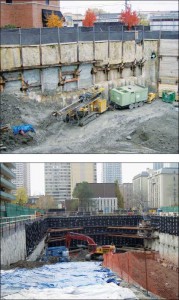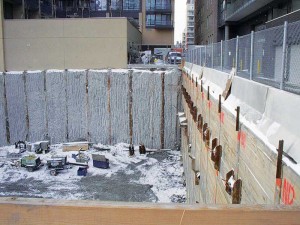Specifying construction vibration requirements

Section C––Section D of bylaw
If the zone of influence extends beyond the legal boundaries of the construction site, then the proponent must proceed to Section C of the form, which requires:
- pre-construction survey consultations with property owners and occupants within the ZOI;
- pre-construction measurement of background (i.e. ambient) vibration;
- pre-construction inspection of adjacent buildings and structures within the ZOI;
- identification of vibration mitigation measures;
- a vibration monitoring program; and
- a public communications and complaint protocol.
The proponent is required to have a report prepared by a professional engineer detailing the above items. Typically, the acoustical engineer will carry out the above steps except for the pre-construction consultations, which are best done primarily by the builder, and the pre-construction survey, which is best done by an experienced structural engineer. The bylaw recognizes access to other properties for a preconstruction survey may not be available.
The public communications and complaint protocol is intended to notify the local councillor, owners, and occupants of properties within the ZOI of the intended construction activity. It also provides the neighbours with the means to communicate problems.
On receipt of a complaint, the applicant is immediately required to do vibration measurements at the complainant’s location, with the offending operation occurring, to relate results to the vibration limits and assess potential impact. If the vibration limits are shown to be exceeded, the offending activity must be stopped immediately until mitigation measures are implemented to achieve compliance (or alternate methods are used that would result in compliance).

Monitoring
Section E of the bylaw deals with monitoring. The program must include at least one seismograph (i.e. vibration monitor) to continuously measure vibration while construction equipment is operated. Additional monitoring locations may be required, subject to surrounding buildings.
Vibration monitors are typically placed within the neighbouring buildings or structures within the ZOI. In a few cases, these authors have found neighbouring properties have been unwilling to have a monitor installed at their location, even though the purpose is to protect them from any unwanted vibration. This reaction is clearly counterintuitive.
The authors’ means of implementation is to continuously monitor with state-of-the-art instrumentation. If a preset vibration threshold (typically set below the bylaw’s limits) is exceeded, a prompt warning is provided to the client and his contractor, indicating there is a risk of vibration excess. This allows the contractor to assess and modify the activities to avoid non-compliance.
Reports giving a summary of measured results are submitted regularly, providing a permanent record of the actual vibration levels during the construction activity.
Conclusion
In the time since the enactment of the bylaw, interest in this type of rigorous construction vibration prediction and monitoring has been steadily increasing in other places. Clients in other jurisdictions have requested similar monitoring when constructing adjacent to sensitive or historic buildings, even though it is not a mandatory requirement as is now the case in Toronto. The process is seen as a valid means of minimizing the risk of vibration complaints and litigation.
The concepts and procedures in Toronto’s Vibration Control Bylaw are effective means of protecting both neighbouring land owners from potential damage due to vibration, as well as builders/contractors from claims for perceived damage due to their construction activities.
Ian L. Matthew, MSc., P.Eng,. is an acoustical engineer at Valcoustics Canada Ltd. He joined the company in 2007 after completing a master’s degree in acoustical engineering. Matthew is responsible for field measurements, analysis, computations, and report preparation for both environmental noise and vibration assessment and architectural acoustics projects. He has appeared as an expert witness in acoustics and has also been involved with writing noise guidelines for all levels of government. Matthew can be reached via e-mail at ian@valcoustics.com.
Al Lightstone, PhD, P.Eng., is the president of Valcoustics Canada Ltd. A designated consulting engineer, he has been active in the field of acoustics for more than 35 years. Lightstone regularly provides his expertise relating to architectural and environmental acoustics, noise and vibration measurement, and control. Typical projects range from studios and theatres, hospitals, schools, and industrial/commercial facilities to residential developments. He is the examiner in acoustics for the Royal Architectural Institute of Canada (RAIC), and has participated several times as an invited lecturer at the Ministry of Environment (MOE) course on Acoustics Technology in Land Use Planning. Lightstone has also been a member of several MOE technical committees dealing with environmental noise analysis, procedures, and formulation of guidelines. He has appeared as an expert witness in acoustics before the Ontario Municipal Board, Environmental Assessment Board, and the courts more than 100 times, and has published numerous technical papers on noise and vibration. Lightstone can be contacted at solutions@valcoustics.com.







